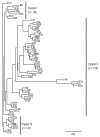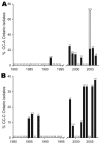New endemic Legionella pneumophila serogroup I clones, Ontario, Canada
- PMID: 20202420
- PMCID: PMC3322000
- DOI: 10.3201/eid1603.081689
New endemic Legionella pneumophila serogroup I clones, Ontario, Canada
Abstract
The water-borne pathogen Legionella pneumophila serogroup 1 (Lp1) is the most commonly reported etiologic agent of legionellosis. To examine the genetic diversity, the long-term epidemiology, and the molecular evolution of Lp1 clinical isolates, we conducted sequence-based typing on a collection of clinical isolates representing 3 decades of culture-confirmed legionellosis in Ontario, Canada. Analysis showed that the population of Lp1 in Ontario is highly diverse and combines lineages identified worldwide with local strains. Identical types were identified in sporadic and outbreak-associated strains. In the past 15 years, the incidence of some lineages distributed worldwide has tended to decrease, and local endemic clones and lineages have emerged. Comparative geographic distribution analysis suggests that some lineages are specific to eastern North America. These findings have general clinical implications for the study of Lp1 molecular evolution and for the identification of Lp1 circulating strains in North America.
Figures






Similar articles
-
Prevalence of sequence types among clinical and environmental isolates of Legionella pneumophila serogroup 1 in the United States from 1982 to 2012.J Clin Microbiol. 2014 Jan;52(1):201-11. doi: 10.1128/JCM.01973-13. Epub 2013 Nov 6. J Clin Microbiol. 2014. PMID: 24197883 Free PMC article.
-
Molecular typing of Legionella pneumophila serogroup 1 clinical strains isolated in Italy.Int J Med Microbiol. 2014 Jul;304(5-6):597-602. doi: 10.1016/j.ijmm.2014.04.004. Epub 2014 Apr 26. Int J Med Microbiol. 2014. PMID: 24881962
-
Genome Sequencing Links Persistent Outbreak of Legionellosis in Sydney (New South Wales, Australia) to an Emerging Clone of Legionella pneumophila Sequence Type 211.Appl Environ Microbiol. 2018 Feb 14;84(5):e02020-17. doi: 10.1128/AEM.02020-17. Print 2018 Mar 1. Appl Environ Microbiol. 2018. PMID: 29247056 Free PMC article.
-
Legionella pneumophila: population genetics, phylogeny and genomics.Infect Genet Evol. 2009 Sep;9(5):727-39. doi: 10.1016/j.meegid.2009.05.004. Epub 2009 May 18. Infect Genet Evol. 2009. PMID: 19450709 Review.
-
[Environmental diffusion of Legionella and of cases of legionellosis].Ann Ig. 1992 Mar-Apr;4(2):89-98. Ann Ig. 1992. PMID: 1283949 Review. Italian. No abstract available.
Cited by
-
Unusual Legionnaires' outbreak in cool, dry Western Canada: an investigation using genomic epidemiology.Epidemiol Infect. 2017 Jan;145(2):254-265. doi: 10.1017/S0950268816001965. Epub 2016 Oct 20. Epidemiol Infect. 2017. PMID: 27760576 Free PMC article.
-
Characterization of Legionella pneumophila Populations by Multilocus Variable Number of Tandem Repeats (MLVA) Genotyping from Drinking Water and Biofilm in Hospitals from Different Regions of the West Bank.Pathogens. 2020 Oct 22;9(11):862. doi: 10.3390/pathogens9110862. Pathogens. 2020. PMID: 33105606 Free PMC article.
-
A Proactive Environmental Approach for Preventing Legionellosis in Infants: Water Sampling and Antibiotic Resistance Monitoring, a 3-Years Survey Program.Healthcare (Basel). 2019 Mar 8;7(1):39. doi: 10.3390/healthcare7010039. Healthcare (Basel). 2019. PMID: 30857147 Free PMC article.
-
Prevalence of sequence types among clinical and environmental isolates of Legionella pneumophila serogroup 1 in the United States from 1982 to 2012.J Clin Microbiol. 2014 Jan;52(1):201-11. doi: 10.1128/JCM.01973-13. Epub 2013 Nov 6. J Clin Microbiol. 2014. PMID: 24197883 Free PMC article.
-
Prevalence of Infection-Competent Serogroup 6 Legionella pneumophila within Premise Plumbing in Southeast Michigan.mBio. 2018 Feb 6;9(1):e00016-18. doi: 10.1128/mBio.00016-18. mBio. 2018. PMID: 29437918 Free PMC article.
References
-
- Fraser DW, Tsai TR, Orenstein W, Parkin WE, Beecham HJ, Sharrar RG, et al. Legionnaires’ disease: description of an epidemic of pneumonia. N Engl J Med. 1977;297:1189–97. - PubMed
-
- Glick TH, Gregg MB, Berman B, Mallison G, Rhodes WW Jr, Kassanoff I. Pontiac fever. An epidemic of unknown etiology in a health department: I. Clinical and epidemiologic aspects. Am J Epidemiol. 1978;107:149–60. - PubMed
-
- Euzeby JP. List of prokaryotic names with standing in nomenclature—genus Legionella [cited 2008 Oct 29]. http://www.bacterio.cict.fr/l/legionella.html
-
- Yu VL, Plouffe JF, Pastoris MC, Stout JE, Schousboe M, Widmer A, et al. Distribution of Legionella species and serogroups isolated by culture in patients with sporadic community-acquired legionellosis: an international collaborative survey. J Infect Dis. 2002;186:127–8. 10.1086/341087 - DOI - PubMed
-
- Vergis EN, Akbas E, Yu VL. Legionella as a cause of severe pneumonia. Semin Respir Crit Care Med. 2000;21:295–304. - PubMed
Publication types
MeSH terms
Substances
LinkOut - more resources
Full Text Sources
Other Literature Sources
Medical
Miscellaneous
